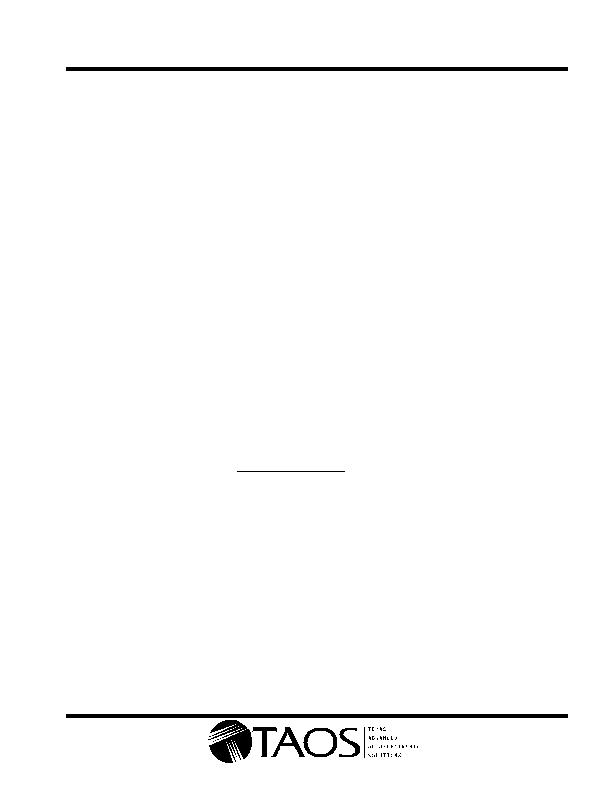- 您现在的位置:买卖IC网 > Datasheet目录57 > TSL2014 (AMS-TAOS USA Inc)IC LINEAR SENSOR ARRAY 896X1 Datasheet资料下载
参数资料
| 型号: | TSL2014 |
| 厂商: | AMS-TAOS USA Inc |
| 文件页数: | 8/11页 |
| 文件大小: | 592K |
| 描述: | IC LINEAR SENSOR ARRAY 896X1 |
| 标准包装: | 30 |
| 系列: | * |

TSL2014
896 y 1 LINEAR SENSOR ARRAY
TAOS040C AUGUST 2011
7
The LUMENOLOGY r Company
r
r
Copyright E 2011, TAOS Inc.
www.taosinc.com
APPLICATION INFORMATION
Integration Time
The integration time of the linear array is the period during which light is sampled and charge accumulates on
each pixels integrating capacitor. The flexibility to adjust the integration period is a powerful and useful feature
of the TAOS TSL2xx linear array family. By changing the integration time, a desired output voltage can be
obtained on the output pin while avoiding saturation for a wide range of light levels.
Each pixel of the linear array consists of a light-sensitive photodiode. The photodiode converts light intensity
to a voltage. The voltage is sampled on the Sampling Capacitor by closing switch S2 (position 1) (see the
functional block diagram on page 1). Logic controls the resetting of the Integrating Capacitor to zero by closing
switch S1 (position 2).
At SI input (Start Integration), pixel 1 is accessed. During this event, S2 moves from position 1 (sampling) to
position 3 (holding). This holds the sampled voltage for pixel 1. Switch S1 for pixel 1 is then moved to position
2. This resets (clears) the voltage previously integrated for that pixel so that pixel 1 is now ready to start a new
integration cycle. When the next clock period starts, the S1 switch is returned to position 1 to be ready to
start integrating again. S2 is returned to position 1 to start sampling the next light integration. Then the next pixel
starts the same procedure. The integration time is the time from a specific pixel read to the next time that pixel
is read again. If either the clock speed or the time between successive SI pulses is changed, the integration time
will vary. After the final (n
th
) pixel in the array is read on the output, the output goes into a high-impedance mode.
A new SI pulse can occur on the (n+1) clock causing a new cycle of integration/output to begin. Note that the
time between successive SI pulses must not exceed the maximum integration time of 100 msec.
The minimum integration time for any given array is determined by time required to clock out all the pixels in
the array and the time to discharge the pixels. The time required to discharge the pixels is a constant. Therefore,
the minimum integration period is simply a function of the clock frequency and the number of pixels in the array.
A slower clock speed increases the minimum integration time and reduces the maximum light level for saturation
on the output. The minimum integration time shown in this data sheet is based on the maximum clock frequency
of 5 MHz.
The minimum integration time can be calculated from the equation:
T
int(min)
+
1
maximum clock frequency
n
where:
n is the number of pixels
In the case of the TSL2014, the minimum integration time would be:
T
int(min)
+ 200ns 896 + 179.2ms
It is important to note that not all pixels will have the same integration time if the clock frequency is varied while
data is being output.
相关PDF资料 |
PDF描述 |
|---|---|
| TSL202R | IC LINEAR SENSOR ARRAY 128X1 |
| TSL208R | IC LINEAR SENSOR ARRAY 512X1 |
| TSL210 | IC LINEAR SENSOR ARRAY 640X1 |
| TSL230BRD-TR | IC LIGHT TO FREQUENCY CONV 8SOIC |
| TSL235RSM-LF | IC LIGHT TO FREQUENCY CONV 3SMD |
相关代理商/技术参数 |
参数描述 |
|---|---|
| TSL201CL | 制造商:TAOS Inc 功能描述:IC LINEAR SENSOR ARRAY 64X1 |
| TSL201CL-LF | 制造商:AMS 功能描述:Linear Sensor Array |
| TSL201R | 功能描述:光频率和光电压 Linear Sensor Array 200dpi 64pix RoHS:否 制造商:ams 峰值波长:1000 nm 工作电源电压:5 V 最大工作温度:+ 85 C 最小工作温度:- 25 C 安装风格: 封装 / 箱体: |
| TSL201RLF | 制造商:TAOS Inc 功能描述:IC LINEAR SENSOR ARRAY CL |
| TSL201-R-LF | 功能描述:IC LIGHT SENSOR ARRAY 8-DIP RoHS:是 类别:传感器,转换器 >> 专用 系列:* 标准包装:40 系列:* |
发布紧急采购,3分钟左右您将得到回复。